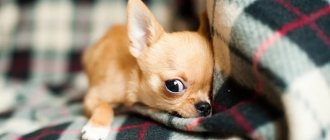1889
Author of the article
Ekaterina Andreeva
Reading time: 8 minutes
A A
When you try to find Chihuahua colors from photos, the list is truly surprising. It’s easy to get lost in all the diversity that opens up to your eyes, which is what some breeders take advantage of, not failing to indicate in the advertisement that their charges are truly unique. I suggest you look into this issue and somewhat systematize the abundance of information in your head.
Prohibited color
I think it’s better to start right away with the colors, which are prohibited by dog handlers. An ordinary Chihuahua lover who does not understand the breed, when viewing a photo, may be touched by cute dogs with a color reminiscent of marble. I agree, a small dog with such spots and stains actually looks cute.
This merle color is achieved due to the uneven coloring of the hairs. It doesn’t matter what kind of stains a smooth-haired or long-haired animal has - they can be black or brown . The main thing is that part of the pile differs in palette. For the first time, breeders had to deal with such a rare dog in the 90s in America.
IMPORTANT: I do not recommend focusing on those breeds of dogs that are also marbled. This list includes the dachshund, collie, and Australian shepherd.
Chihuahuas are a completely different story. The puppy may well be deaf, blind, or have other eye problems. In especially severe cases, the animal is born without organs of vision and hearing. Sometimes it can be sterile - I think under the circumstances it's clear why that's a good thing.
Often a dog of this color dies at birth. Especially at risk are the so-called “double merles” - that is, animals in which both parents were defective. Such animals sometimes face problems related to bones and heart. In addition to those I listed above.
Prohibited gene in the breed
With all the incredible abundance of shades and their combinations in this breed, however, there is one color that is subject to categorical rejection. This is a merle Chihuahua, also known as marbled. And the ban on it is by no means a whim of dog handlers.
Such an individual can be distinguished by areas with unevenly colored dark gray or beige fur, which creates a “marbled” effect. The eyes of these dogs are often watery blue. For the first time an individual of this color appeared in the 90s in one of the nurseries in the USA. Since this gene has shown itself to be dominant, but has never been presented before, it is believed that the Chihuahua “got it” from another breed as a result of accidental crossing or a failed breeding experiment (there is a theory that with dachshunds).
The gene that is responsible for the appearance of merle-colored Chihuahuas is designated M. If both parents are carriers of this gene, the puppies are likely to be blind or have other congenital eye problems. They are often deaf, and in particularly severe cases they are born without eyes or ears at all. Often these offspring die immediately after birth or while still in the womb due to pathological abnormalities incompatible with life. However, even if the merle grows up, it may be completely sterile or there is a deficiency of sperm in males.
There are dog breeds where merle is allowed because it does not harm their health (for example, collie, Australian shepherd, dachshund, etc.), but this does not apply to chihuahuas.
The problem is that due to the dominance of the M gene, it can “sleep” in many modern individuals of other colors. Strict culling would help, but due to the fact that the merle-colored Chihuahua looks beautiful, a large number of unscrupulous breeders, or even simply irresponsible fanciers, continue to breed these dogs, increasingly “infecting” the breed. At the moment, merle is banned in a number of countries, and in others it is considered a disqualifying characteristic.
Similar article: Chihuahua breed weight table by month
The worst variety is considered to be a “double merle”, that is, an individual in which both parents were merles. They often have problems with the heart, bones and reproductive system. As we have seen, Chihuahuas can have a huge number of colors, including very unusual and rare ones. So you can easily choose a healthy puppy of the approved type and not encourage unscrupulous businessmen from whom you can buy an absolutely sick dog for a lot of money.
We recommend this article:
Overview of the official types of the Chihuahua breed
White and black colors
A dark and light palette of this kind is usually considered a classic, but in the case of a Chihuahua, things are a little different:
- The black dog is, oddly enough, rare. I mean, in its purest form. For, as a rule, there is a small white spot in the area of the chest and paws.
- White – this color in mono version is also quite rare.
- Spotted – but this kind of animal can be found more often. This is, for example, a light dog and black spots included. They are contrasting, large, located on the head and torso. Or it is a dark representative with small white spots, as I wrote about above.
Rare colors of Chihuahua
Rare Chihuahua colors include chocolate, white, brindle, lilac (lilac) and blue. They, like common colors, can have a huge number of combinations. Let's look at the most famous ones.
Related article: Features of caring for long-haired Chihuahuas
- Chocolate
Chocolate implies brown fur with a warm reddish tint (the pads on the paws and nose should also be brown). It can be clean or with small marks on the paws and chest. The “sable” type has a chocolate base color, the rest is like a red sable. At the same time, small milky inclusions are unacceptable: white should either be expressed in clear spots (can be on the head, chest, tail and paws), or it should not be there at all. “Sable” can also be chocolate-red: a light chocolate shade with the same dark stripe from head to tail. There is a tan color option with lightened areas. The chocolate tricolor looks interesting: a predominantly white body (in some cases there may be brown specks on it - the so-called specks) with a chocolate-colored cloak and light red tan.
- White
The white color of the Chihuahua is also found in its pure form. In this case there should be no marks or specks. This coat color is complemented by pink skin, black or brown nose and claws.
Often white serves as a “background” for other colors. There may be large red, gold and chocolate spots. Individuals with cream-colored markings look elegant. Spectacular graphics are inherent in individuals of the black and white type.
- brindle
There are a lot of variations here. In Chihuahuas, the brindle color is considered to be either fawn of any gradation or thick black. The brindle coloring allows for many types of patterns, for example, light fawn with black stripes or deep black diluted with fawn and tan. You can also find a dog whose white “base” is painted with tiger spots located on the head and/or body.
- Lilac
A beautiful and rare variety. There may be different saturation options. This Chihuahua's fur can be so light purple in color that it literally looks pink (called an Isabella). A dark purple coat type is also possible. White tips on the paws and small spots on the chest are allowed (tan type). Lilac allows options with large white spots on the main background (can be located anywhere except on the sides and back) or, conversely, purple spots with a main white background. A lilac tricolor is possible. A long-haired individual of this type looks especially impressive.
Related article: How old do Chihuahua dogs grow?
- Blue
The blue Chihuahua can be either a rather dark gray color or a very delicate, smoky color. There are variants of blue color with white splashes on the chest and tips of the paws; large, clearly defined white spots on a blue background are acceptable, and vice versa. The blue and white variety is sometimes decorated with specks. This type has a beautiful tricolor: a blue cloak on a white body with light red tan.
Advantages and disadvantages
Pros:
- look elegant and stylish;
- sociable and affectionate;
- distinguished by loyalty and devotion;
- they don’t need a lot of space in the house;
- if necessary, without hesitation they rush to protect the owner;
- sensitive and distrustful of strangers, which makes them good guards;
- willingly use the tray and diaper;
- easy coat care;
- love traveling;
- with the right approach they are easy to train.
Minuses:
- monogamous, tend to choose one owner;
- not suitable for families with children under 11-12 years of age;
- need very careful handling, as they have fragile bones and an open fontanel;
- may be jealous of the owner of other dogs and even children;
- they are cocky and do not get along very well with dogs of other breeds;
- an individual approach to training is needed.
IMPORTANT!
If not raised correctly, a black Chihuahua can grow up to be aggressive and even biting.
Does a puppy's color change as it ages?
Most black Chihuahua puppies do not fade and retain their jet black coat color. An exception may be dogs that were born black, but later began to change color to sable. But they are noticeable almost immediately, since their coat color is not black, but rather brownish.
IMPORTANT!
Black Chihuahuas that carry the brown, red, or fawn gene may appear dark brown or brownish. In order to determine what color a dog is, just look at its nose - if it is brown, then the dog is chocolate. True black Chihuahuas will always have a black nose.
How to choose a future pet
Choosing a puppy begins with selecting a kennel with a good reputation, where the purchase should take place. It is best to read reviews of the shelter and talk to people who have used it, as this will give you a definite impression.
Useful tips for choosing Chihuahua puppies:
- When starting to choose, you should not give in to the temptation and take the puppy that you like best based on its color and eye color. Initially, you need to pay attention to his state of health and purebred. There is no need to choose pets with discharge from the eyes, an unpleasant odor from the mouth, traces of alopecia and unkempt fur.
- It is also better to avoid overly melancholic and cowardly animals, especially if it is an adult dog. It is best to give preference to the pet that was the first to go to the meeting.
- Buying a mixed breed in order to save money is also not the best idea. The overwhelming percentage of such dogs have congenital pathologies, and they are also characterized by unstable psyche.
- When choosing, the gender of the pet also plays an important role. Chihuahua girls are more capricious, while boys, on the contrary, are obedient. Girls, unlike boys, mark their territory less, which is an undeniable advantage.
- You should also pay attention to the weight of your pet. A puppy at the age of 3 months should not weigh less than 0.5 kg and more than 2.7 kg.
Important! Having decided on a specific pet, you should check whether the breeder has documents for it. Documents on vaccinations performed are also subject to verification.
It is important to be responsible when choosing a puppy so as not to purchase an unhealthy pet.
The black Chihuahua is a unique pet that has not only attractive external features, but also a wonderful character, of course, subject to proper training. You just need to choose a dog that is suitable in character, who will eventually become a reliable friend.











